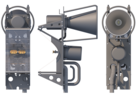Horn radiator

A horn antenna ( English horn antenna ) is a construction of an antenna for microwaves and consisting of a the form of a Exponentialtrichters approximated metal surface, thus a Exponentialleitung , often via a hollow conductor is fed. In the case of an antenna used for reception (and not for transmission ) (as in the picture), the term “radiator” is misleading. Instead, it is better to speak of a horn antenna .
They are used as independent antennas, for example for directional radio links , or as feed antennas in the focal point of parabolic antennas ( radar antennas, radio telescopes , directional radio antennas, shell antennas ). Different designs also lead to names such as pyramidal horn and cone horn.
principle
In principle, the waveguide , which conducts the transmission power to the antenna, can radiate the electromagnetic wave from its open end into free space. The wave resistance of the vacuum has a different value than the waveguide. For this reason, unwanted reflections occur at this point. Therefore, the mechanical dimensions of the waveguide are expanded at the point of radiation exit of the electromagnetic wave in order to achieve a gradual transition. This construction is called horn radiator because of its horn-like shape.
In the case of microwave antennas, the combination of a primary radiator and a secondary reflector is common, with a horn radiator ( feed ) often being used as the primary radiator at the focal point of a metallic parabolic mirror .
properties
Horn antennas have a comparatively high focus in the directional characteristic . The larger the geometrical dimensions of the horn antenna compared to the wavelength, the more the emitted power is bundled, which results in a high directivity factor . A wall of the horn can be shaped as a section of a paraboloid ; the feeding waveguide meets the horn laterally. With this form, particularly high directivity and front-to-back ratios can be achieved. This form was previously used in radio telescopes and directional radio antennas, with dimensions of up to several meters in width.
In today's systems for satellite communication, grooved horn radiators are mostly used to feed parabolic antennas . These allow a smaller overall length and width. The size of horn radiators depends on the frequency - the higher the frequency to be emitted or received, the smaller horn radiators and also grooved horn radiators can be built. The dimensions range from approximately only 20 mm to 100 mm in diameter for feeding parabolic antennas up to several meters in diameter for paraboloid horn antennas.
Grooved horn radiator for 3.7 to 6 GHz
Horn antenna (above) of the FuMB "Tunis" used on German submarines in World War II
Steghorn radiator
A special design is the web horn often called double Steghorn (Engl. Double-ridged waveguide horn ). In the middle of the upper and lower broad side of the horn antenna there are exponentially outward-opening metallic webs that cause a significant increase in the bandwidth of the antenna. A relative bandwidth of at least 6 is typically achieved in this way, which means that the horn antenna is also suitable for emitting pulses. The Vivaldi antenna is a planar variant of the Steghorn radiator.
TEM horn antenna
The TEM horn radiator is a design of a very broadband test antenna and consists of a combination of two electrically isolated metal surfaces approximated to the shape of an exponential funnel, which is used in the close range to emit a TEM wave . It is used, among other things, in the context of near-field measurements for electromagnetic compatibility .
Web links
- Data sheet of a steghorn radiator (English, PDF, 600.5 KiB)
Individual evidence
- ^ Hans Heinrich Meinke , Friedrich-Wilhelm Gundlach : Pocket book of high frequency technology . Springer, Berlin 1986 (4th edition), p. N 43. ISBN 3-540-15393-4



